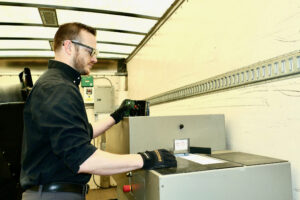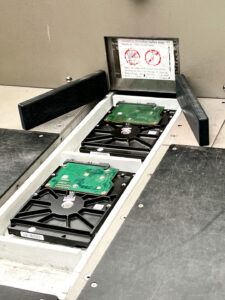What Is a Degausser and How Does It Work?
Degaussing Basics: What Is a Degausser?
A degausser (also known as a demagnetizer) is a machine that disrupts and eliminates magnetic fields stored on tapes, disks, and hard drives. The process of degaussing changes the magnetic domain where data is stored, making it unreadable and unable to be recovered. Degaussing neutralizes the magnetic field on the media, permanently erasing all data and formatting by randomizing magnetic domains.
In other words, when you degauss a hard drive, you’re not just deleting files—you’re erasing the magnetic blueprint that makes data retrievable in the first place.
Degaussing services are a vital step in secure IT asset disposition, especially in industries where data privacy is non-negotiable.
How a Degaussing Machine Works
A degaussing machine—sometimes called a demagnetizer, generates a strong, controlled magnetic field that overwhelms the existing magnetization of your storage media. Whether it’s an LTO backup tape or a spinning HDD, the degausser magnet inside the machine alters the alignment of magnetic particles, making previously stored data unreadable and impossible to recover.
The strength of the magnetic field is measured in Oersteds (Oe), which helps determine which type of degausser is needed. For example, most modern hard drives require 5,000 Oe or more for successful hard disk degaussing.
Degaussing is effective only on magnetic media such as hard disk drives (HDDs), VHS tapes, audio cassettes, and magnetic backup tapes like LTO and DLT. They are ineffective on non-magnetic media such as solid-state drives (SSDs), optical discs (CD/DVD/Blu-ray), or USB flash drives. Degaussing is one of the best steps to take before destroying or shredding hard drives. It gives you extra protection against someone gaining unauthorized access to your data.
Degaussing Terms to Know
When exploring degaussing services, it helps to understand a few key terms:
- Oersted (Oe): A unit of magnetic field strength. You’ll find Oe ratings of about 1800 or higher for current tapes, while hard drives can easily reach 5,000 Oe. These energy level ratings tell you how strong of a degausser you’ll need to destroy the data stored on the device. Higher values mean you’ll need a stronger degausser magnet to degauss a hard drive successfully.
- Coercivity: You’ll see coercivity used interchangeably with Oersted in many instances because Coercivity is the amount of magnetic field strength required to reduce a material’s magnetization to zero after it has been magnetized. Essentially, this is a rating of how easy or difficult it will be to demagnetize your magnetic media. Like Oersteds, higher coercivity means you need a more powerful hard drive degausser.
In short: the denser or more resistant your magnetic media, the more robust your degaussing hard drive process must be.
Why Degaussing Efficiency Depends on Design
The design of a degausser plays a crucial role in determining how effectively it can erase data from magnetic media. At the core of its functionality is the ability to generate a substantial magnetic field, which is vital for erasing data.
Magnetic Field Dynamics
A powerful magnetic field is essential for altering the polarity of the particles in magnetic media, thereby erasing the data. The effectiveness of this magnetic field is primarily influenced by the design of the degausser. Specifically, the coils within the device are fundamental—they generate the magnetic field required for data erasure.
- Strength of Coils: To ensure complete data removal, the strength of these coils must be two to three times that of the media’s magnetic properties. Even stronger fields are necessary for highly sensitive data, such as those classified as Restricted or Top Secret.
- Measurement: This magnetic strength is often measured in Oersteds, honoring Hans Christian Oersted’s contribution to understanding electromagnetic interactions.
Efficiency Enhancements in Design
To further enhance efficiency, degaussers are designed with various features:
- Multi-Axial Coil Orientation: Utilizing multiple coils in different orientations creates a more comprehensive magnetic field, ensuring thorough data erasure.
- Rotation Mechanism: Some designs incorporate the coils’ rotation or the media itself. This movement allows the magnetic field to interact with all media parts, enhancing the degaussing process.
Media Transport Mechanism
How media is transported through the magnetic field also impacts efficiency. Degausser designs may include:
- Belt Conveyors: Automatically transport media at a consistent speed, ensuring uniform exposure to the magnetic field.
- Motorized Spindles: Rotate the media, optimizing the field’s interaction with its entire surface.
In summary, the degausser’s efficiency hinges on its ability to produce a dynamic and powerful magnetic field and its media handling mechanisms. These devices maximize data erasure through thoughtful design, catering to varying security requirements and media types. At Securis, our NSA-approved LM4 degausser includes all these design efficiencies and more, making our hard drive degaussing service one of the most effective available.
How Magnetic Media Density Influences the Degaussing Process
The density of magnetic media plays a crucial role in determining the effectiveness of the degaussing process. In high-density media, data is stored in closer proximity, making it more challenging to erase thoroughly. Consequently, a more powerful degausser is essential to ensure complete data removal.
Key Considerations:
- Density Levels: Denser media, like modern hard drives, require a degausser capable of generating a stronger magnetic field. This ensures every bit is reset, wiping all traces of information.
- Degaussing Power: Selecting a degausser with adequate power is critical. Not all degaussers are created equal; some might fall short when dealing with high-density media. Using equipment on the approved list for the NSA can ensure you have sufficient power. Using an underpowered degausser on dense media can lead to incomplete data erasure, posing a security risk.
Understanding and considering the density of your magnetic media is key to selecting the right degaussing tool. Working with a vendor like Securis, which uses NSA-approved Degaussing equipment, can ensure the tools used are the right match and ensure data is irretrievably erased, maintaining your security and allowing for peace of mind.
Can a Degaussed Hard Drive be Reused?
This is a common question: can a degaussed hard drive be reused?
In most cases, the answer is no. While some older magnetic media like VHS tapes or reel-to-reel audio tapes might still function post-degaussing, modern hard drives become unusable. Once the magnetic domains are randomized, the drive’s firmware and calibration are wiped out. For secure hard drive data destruction, that’s exactly what you want.
 Why Degaussing Is Still Relevant
Why Degaussing Is Still Relevant
You might be wondering: what does a degausser do that other data destruction methods don’t?
Unlike software overwrites or formatting, degaussing offers:
- Complete Data Erasure: Nothing can be recovered, even with advanced forensic tools.
- Hardware-Neutral Destruction: Works on failed or non-functioning drives.
- Fast & Scalable: Ideal for large volumes of retired IT assets.
Secure data erasure is also often required by regulations in healthcare, government, and finance. It’s not optional—it’s part of compliance.
Can a Degausser Destroy an SSD? (Solid State Drive)
Solid-state drives are not magnetic media, so they can’t be erased using a degausser. Because SSDs store data electronically on NAND flash chips (not magnetically), degaussing is ineffective. SSDs should be shredded to particles no larger than 2mm for secure disposal, following NSA/CSS SSD destruction standards.
It’s important to know that solid-state drives (SSDs), optical discs (CD/DVD/Blu-ray), or USB flash drives cannot be degaussed. Why? These types of data storage devices do not store data magnetically, so degaussing magnets are useless here. Instead, these devices must be physically shredded to particles no larger than 2mm for secure disposal, following NSA/CSS SSD destruction standards. This is why Securis includes hard drive shredding as a redundancy step, especially for environments that mix drive types.
Do You Need Degaussing Services?
If your old equipment contains personally identifiable information (PII), financial records, or health data, the answer is clear: yes. Degaussing hard drives is one of the most secure ways to ensure your data won’t fall into the wrong hands.
Whether you’re handling classified data, managing a healthcare network, or decommissioning hundreds of legacy devices, degaussing should be a part of your IT asset disposition services.
Securis offers both on-site data destruction (from our 26’ box truck) and off-site degaussing at our NAID-certified facility. Our team verifies and recertifies every degausser machine annually, and we track each device processed with an audit-ready inventory report and certificate of destruction.
 Securis Degaussing Services for the Ultimate in Secure Data Destruction
Securis Degaussing Services for the Ultimate in Secure Data Destruction
Degaussing provides the most reliable, efficient, and hardware-independent solution for complete data erasure, ensuring that sensitive information is fully protected from unauthorized recovery. If you are looking for hard drive degaussing services, look no further.
- Securis provides compliant on-site and off-site degaussing services for hard drives, backup LTO and DLT tapes.
- The degausser is internally mounted and powered by our 26’ box truck so that mobile hard drive degaussing services can be completed at your site, allowing you to witness the process. However, we can also complete the degaussing services off-site at our secure, NAID-certified facility.
- Our NSA-approved LM4 degausser is used for optimum data destruction.
- Our hard drive and tape degaussing service options are fully compliant with all National Institute of Standards and Technology (NIST) Special Publication Series 800-88 and National Industrial Security Program (NISP) Operating Manual 32 CRF Part 117 (which replaced DOD 5220.22-M).
- Monitoring of the magnetic fields is done via a program called FieldCheckR. Our degausser is verified before every degaussing process to ensure it properly functions. Our degausser is recertified annually by the manufacturer.
- Securis offers hard drive shredding as an added redundancy to ensure absolute data destruction. Because a degaussed drive and a non-degaussed drive physically do not look different, it is a best practice to shred drives after they are degaussed.
Ready to Protect Your Data?
Don’t leave secure data disposal to chance. Trust Securis for NSA degaussing compliance, magnetic media destruction, and full-spectrum IT asset disposition services.
👉 Request a Quote for Degaussing Services Today